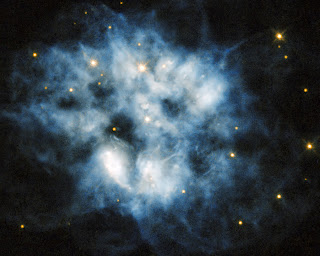, because he finished all his "fuel". , Not eternal stars shine in fact: if the core unstable releases large amounts of energy that burns the atmosphere around the star until it boils down to what we see in the impressive image of the Hubble Telescope, NASA / ESA made. It is in the constellation of Puppis, in the southern hemisphere, and was discovered in 1847 by John Herschel.
In the center of this cloud blue, almost like the haze, let's see what remains of the star, now weak, cold and very dense.In reality there is a button white dwarf , more or less the size of the Earth. This is to mean that its brightness varies by waves caused by gravity , which plays through the little star .
When Herschel discovered NGC 2452 has called " a task that I can not define the nature. Certainly not a star, not a double star [ ...] . Which to mention call a planetary nebula elongated . " In the eyes of the observer at the time of Herschel , the telescopes used are very different from those of today , have planetary nebulae often than gas planets ( like Jupiter , for example) interpreted . Modern telescopes have made it clear that it actually ejects the outer layers of dying stars into space in the final stages of their lives.
Astronomers believe that in 5 billions years, the same fate will befall the sun.
When Herschel discovered NGC 2452 has called " a task that I can not define the nature. Certainly not a star, not a double star [ ...] . Which to mention call a planetary nebula elongated . " In the eyes of the observer at the time of Herschel , the telescopes used are very different from those of today , have planetary nebulae often than gas planets ( like Jupiter , for example) interpreted . Modern telescopes have made it clear that it actually ejects the outer layers of dying stars into space in the final stages of their lives.
Astronomers believe that in 5 billions years, the same fate will befall the sun.

No comments:
Post a Comment